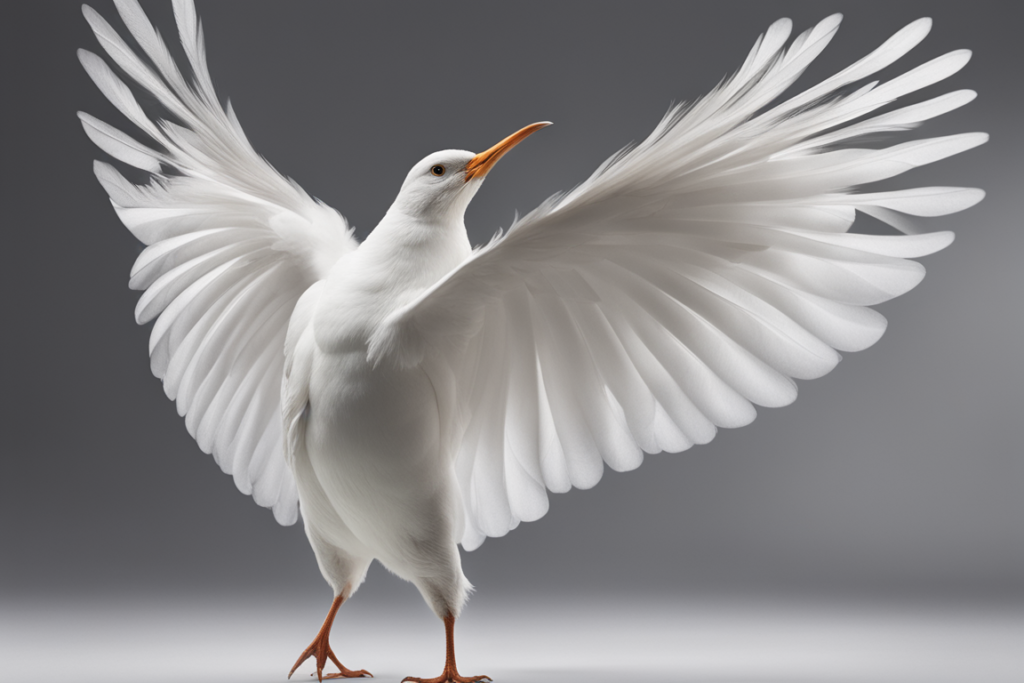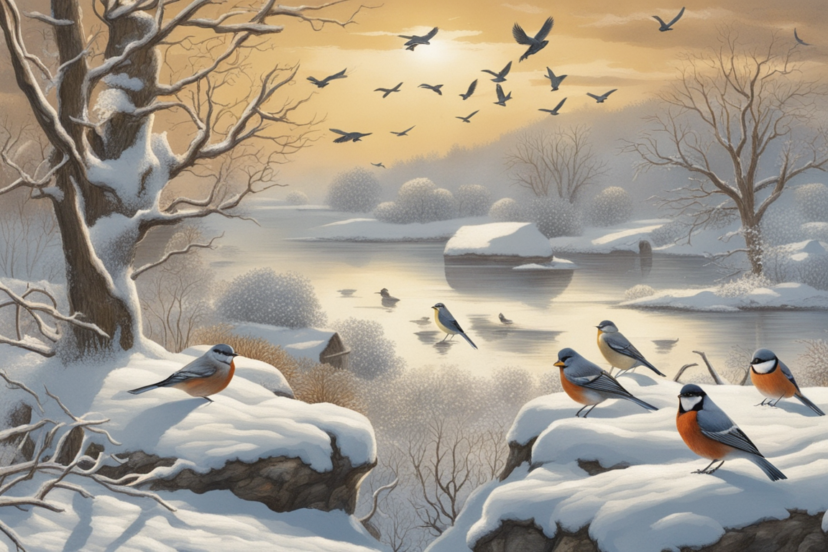Do Birds Get Cold & How Do They Deal with It?
When winter turns the world white, we wonder: do birds get cold just like us? You bet they do! Even though they don’t shiver and complain about frozen toes, cold winters can be tough on our feathered friends. But don’t worry, these amazing creatures have some super cool tricks to stay warm, even when the temperature drops like a snowball! Let’s discover their cozy secrets and awesome ways to survive the coldest months!
Built-in Heaters and Feathery Armor
Birds are warm-blooded, meaning their body temperature stays constant regardless of the weather. Think of them as tiny furnaces, keeping toasty even on the coldest winter days. But how do they prevent this precious body heat from escaping? The answer lies in their remarkable feathers.
Imagine feathers not just as decorative plumage, but as intricate suits of armor. Each feather boasts a complex structure, with tiny interlocking barbs trapping air pockets that act as insulators. This downy underlayer, along with the outer layer of waterproof feathers, creates a barrier against the cold, akin to a miniature down jacket.

Beyond Insulation: Active Strategies for Staying Warm
Feathers are just one piece of the puzzle. Birds employ a range of active strategies to conserve body heat:
- Fluffing Up: When temperatures drop, birds fluff their feathers, creating even more air pockets for enhanced insulation. Picture them turning up their internal thermostat!
- Shivering: Similar to humans, birds can shiver to generate heat. These tiny muscle tremors produce friction, warming them from within.
- Minimizing Heat Loss: Birds tuck their feet into their feathers, reducing exposed surface area and heat loss. Some even stand on one leg at a time, tucking the other into their warm underbelly.
- Sharing Warmth: Huddling together, especially small birds, allows them to share precious body heat and collectively resist the chill.
Migration: A Strategic Retreat
Not all birds face winter head-on. Some birds migrate to escape the cold temperatures. For many, particularly those in colder climates, migration is the ultimate survival strategy. These feathered travelers embark on epic journeys south, seeking warmer climes with ample food resources. Imagine the majestic Canada Goose, its iconic V-formation soaring across vast distances, driven by an innate urge to escape the winter’s grip.

Small Wonders with Big Challenges
For small birds like hummingbirds and chickadees, the challenge of staying warm is amplified. Their high surface area-to-volume ratio means they lose heat faster. To compensate, they have a higher metabolism, consuming vast amounts of food relative to their size. Imagine a tiny hummingbird, flitting from flower to flower, its wings beating furiously, all to fuel its internal furnace!
Beyond Feathers: Adaptations for Diverse Climates
The bird world is diverse, and so are their adaptations. Penguins, for example, boast thick layers of blubber and waterproof feathers, allowing them to thrive in the frigid Antarctic. Arctic Ptarmigans, meanwhile, change their plumage color to match the snowy landscape, both for camouflage and insulation. Each species has evolved unique strategies to conquer the cold.
Helping Our Feathered Friends in Winter
As winter approaches, we can offer a helping hand to our feathered neighbors. Providing bird feeders filled with nutritious seeds like black oil sunflower seeds and suet becomes crucial. Leaving out shallow dishes of water for drinking and bathing is another small act of kindness. Consider offering nesting boxes or shelters, providing much-needed havens from the elements.
Also read: Understanding Bird Behavior in Rain and at Night
Sharing the Warmth and Finding Shelter
Garden birds like robins and finches rely heavily on our support during cold winter months. Offering a diverse menu of bird food, including suet cakes, mealworms, and berry-bearing shrubs, helps them maintain their body weight and energy levels. Additionally, planting native trees and shrubs provides natural shelter and food sources.
Minimizing Heat Loss: One Leg at a Time
Have you ever seen a bird standing on one leg? It’s not just casual; it’s a clever way to save heat! By tucking one leg into their feathers, they reduce exposed skin and heat loss. This, along with fluffing and shivering, helps them weather even the coldest nights.
Winter Days: Sharing Heat and Finding Shelter
As the sun goes down and it gets super cold, birds need extra tricks to stay warm. Big birds like geese huddle close together in cozy holes in trees, sharing their body heat like friends sharing a blanket. This keeps them all toasty on the chilly night.
Smaller birds like chickadees and wrens find tiny hiding spots in trees, cracks in walls, or even special boxes people put up for them. These little shelters protect them from the wind and freezing temperatures, like tiny winter coats. So, even when it’s dark and cold, birds can stay snug and cozy thanks to their cleverness and a little help from us!
Beyond Black Oil Sunflower Seeds: A Diverse Diet for Winter Survival

Sunflower seeds are great for birds, but they’re not the only thing they like! To attract more feathered friends, think of it as offering a yummy buffet. Add nuts, dried fruit, and even special treats like suet cakes to your feeder. It’s like having different flavors for different bird tastes!
Planting berry bushes in your garden is also a good idea. Birds love berries, and they’re especially helpful in winter when other food is hard to find. The more variety you offer, the happier the birds will be!
Late Summer Feasting: Building Fat Reserves for Winter
Before winter arrives, birds know they need to get ready for the cold! They spend late summer and fall eating tons of food, like stuffing their tiny bellies with yummy treats. This extra food helps them build up a layer of fat, like a warm winter coat, to keep them cozy when the snow falls. By knowing this, we can make sure our bird feeders are full of delicious and healthy food during this important time, so they have plenty of energy to stay warm all winter long!
Different Birds, Different Needs: Winter Help Made Easy!
Just like people, birds have different ways of dealing with winter! Tiny hummingbirds, for example, need their sweet nectar fix all year round, so offering heated feeders or sugar water is super important. Bigger birds like geese, on the other hand, love finding food in open water, so making sure nearby ponds or lakes stay unfrozen helps them out a lot. By learning about the special needs of the birds in your area, you can give them just the right winter help they need to thrive!

Project FeederWatch: Citizen Science for Winter Birds
Ever wonder how birds survive the winter? Want to help them out and learn more about them at the same time? Cool! There are programs like Project FeederWatch where you can watch the birds at your feeder and tell scientists what you see. This helps them understand how birds are doing, where they fly to in winter, and even how climate change affects them. It’s like being a bird detective, but way easier than wearing a tiny trenchcoat and magnifying glass!
More Than Just Feathered Friends: The Ecological Importance of Winter Birds
Beyond their beauty and song, birds play a vital role in our ecosystems. By controlling insect populations, dispersing seeds, and pollinating plants, they contribute to a healthy and balanced environment. Supporting winter birds not only benefits these feathered wonders but also ensures the health of our entire ecosystem.
So, Do Birds Get Cold?
Yes! Birds are warm-blooded animals like mammals. They get cold but they are also able to maintain constant body temperatures. Birds stay warm even in cold weather. They have special tricks and adaptations to survive winter’s chilly grip. They’re like tiny furnaces with built-in coats of feathers that trap air to keep them warm. They even puff up their feathers and shake their bodies a little to generate heat, kind of like shivering for us. Plus, they tuck their feet in and huddle together to share warmth, just like friends!
Other birds, though, take a different approach. In very cold places, birds fly south for the cold winter months – like snowbirds escaping to warmer beaches! Others, especially small ones, eat tons of food to keep their tiny bodies warm, like hummingbirds with their fast-beating wings.
No matter what they do, we can help our feathered friends in winter. Put out feeders with yummy seeds and suet, leave some water for them to drink and bathe in, and even offer them cozy shelters to hide from the cold. By helping them stay warm and fed, we can make sure these amazing birds continue to grace our skies all year round!




